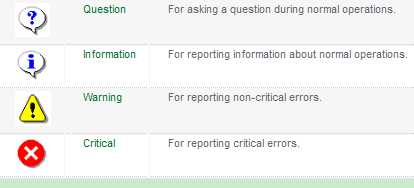标签:返回值 odi ima 51cto qwidget body gif 使用 case
1. QMessagebox 类的几个静态成员函数,可以直接调用创建对话框
| StandardButton | critical(QWidget * parent, const QString & title, const QString & text, StandardButtons buttons = Ok, StandardButton defaultButton = NoButton) |
| StandardButton | information(QWidget * parent, const QString & title, const QString & text, StandardButtons buttons = Ok, StandardButton defaultButton = NoButton) |
| StandardButton | question(QWidget * parent, const QString & title, const QString & text, StandardButtons buttons = StandardButtons( Yes | No ), StandardButton defaultButton = NoButton) |
| StandardButton | warning(QWidget * parent, const QString & title, const QString & text, StandardButtons buttons = Ok, StandardButton defaultButton = NoButton) |

2. static StandardButton QMessageBox::information ( QWidget * parent, const QString & title, const QString & text, StandardButtons buttons = Ok, StandardButton defaultButton = NoButton );
static StandardButton QMessageBox::information ( QWidget * parent, const QString & title, const QString & text, StandardButtons buttons = Ok, StandardButton defaultButton = NoButton );
然后看它那一堆参数,第一个参数parent,说明它的父组件;第二个参数title,也就是对话框的标题;第三个参数text,是对话框显示的内容;第四个参数buttons,声明对话框放置的按钮,默认是只放置一个OK按钮,这个参数可以使用或运算,例如我们希望有一个Yes和一个No的按钮,可以使用QMessageBox::Yes | QMessageBox::No,所有的按钮类型可以在QMessageBox声明的StandarButton枚举中找到;第五个参数defaultButton就是默认选中的按钮,默认值是NoButton,也就是哪个按钮都不选中。
注意,static函数都是要返回一个StandardButton,我们就可以通过判断这个返回值来对用户的操作做出相应。
int ret = QMessageBox::warning(this, tr("My Application"), tr("The document has been modified.\n" "Do you want to save your changes?"), QMessageBox::Save | QMessageBox::Discard | QMessageBox::Cancel, QMessageBox::Save); switch (ret) { case QMessageBox::Save: // Save was clicked break; case QMessageBox::Discard: // Don‘t Save was clicked break; case QMessageBox::Cancel: // Cancel was clicked break; default: // should never be reached break; }
endl;
标签:返回值 odi ima 51cto qwidget body gif 使用 case
原文地址:http://www.cnblogs.com/icmzn/p/7459023.html